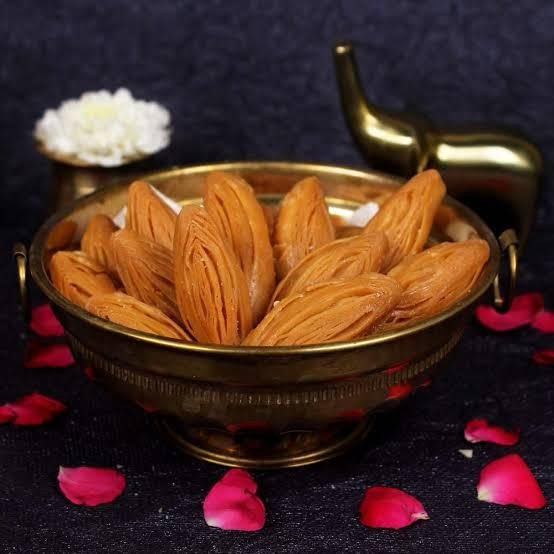
step by step Preparation:
Preparing the Dough:
- Start by sifting the all-purpose flour into a large mixing bowl. Add a pinch of salt to the flour and mix well.
- Melt the ghee and add it to the flour. Rub the ghee into the flour using your fingertips until the mixture resembles breadcrumbs.
- Gradually add water to the flour mixture and knead it into a firm, smooth dough. The dough should be pliable but not too soft.
- Cover the dough with a damp cloth and let it rest for 20-30 minutes.
Rolling and Layering:
- Divide the dough into small portions and roll each portion into a ball.
- Roll out each ball into a thin disc using a rolling pin. The disc should be as thin as possible to create the flaky layers in the Khaja.
- Fold the rolled-out disc in half, then fold it again to form a quarter. Roll it out once more into a thin triangle or square shape.
- Repeat the process with the remaining dough portions.
Frying the Khaja:
- Heat oil or ghee in a deep frying pan over medium heat.
- Once the oil is hot, gently slide in the rolled-out dough pieces into the oil. Fry them on medium heat until they turn golden brown and crisp.
- Remove the fried Khaja from the oil and drain them on paper towels to remove excess oil.
Preparing the Sugar Syrup:
- In a separate pan, combine sugar and water and bring it to a boil. Stir continuously until the sugar dissolves completely.
- Once the sugar syrup reaches a one-string consistency, add cardamom powder (if using) and remove it from the heat.
Coating the Khaja:
- Dip the fried Khaja pieces into the warm sugar syrup, ensuring they are well-coated on all sides.
- Remove the Khaja from the syrup and place them on a wire rack to cool and allow the syrup to set.
Khaja: The Crisp and Sweet Delight from Bihar
Khaja, a traditional sweet from Bihar, holds a special place in the culinary landscape of the region. With its origins tracing back to the ancient city of Silao in the Nalanda district, Khaja is a testament to the rich cultural heritage and time-honored culinary traditions of Bihar. This crispy, layered sweet has been a favorite at festivals, weddings, and religious ceremonies, especially during Chhath Puja, where it is offered to the Sun God as prasad.
Khaja is not just a dessert; it’s a symbol of celebration and togetherness. The process of making Khaja is an art passed down through generations, with each family adding its own touch to the recipe. The result is a flaky, crispy sweet with a delicate balance of sweetness and texture that melts in your mouth with every bite.
The Origins of Khaja:
Khaja’s history is deeply intertwined with the cultural and religious practices of Bihar. It is believed that Khaja was first made in the ancient Magadh region, which is now a part of modern-day Bihar. The sweet was a favorite of kings and emperors, and its recipe was carefully guarded and passed down through royal kitchens.
The town of Silao is particularly famous for its Khaja, where the unique weather conditions are said to play a crucial role in achieving the perfect texture of this sweet. The dry climate of the region helps in creating the flaky layers that are characteristic of Khaja.
Khaja and Chhath Puja:
Chhath Puja, one of the most significant festivals in Bihar, is incomplete without Khaja. The sweet is offered to the Sun God during the puja as a symbol of devotion and purity. It is believed that the Sun God blesses the devotees with health, prosperity, and happiness when Khaja is offered as prasad.
The preparation of Khaja during Chhath Puja is a communal activity, with women in the family coming together to make this delicacy. The process is meticulous, requiring patience and precision, as the dough is carefully rolled out, layered, and fried to golden perfection.
The Art of Making Khaja:
The recipe for Khaja is simple, yet the technique is what makes it special. The key to making perfect Khaja lies in the preparation of the dough and the frying process, which gives it its signature crispiness.
Ingredients:
- 2 cups all-purpose flour (maida)
- 1/4 cup ghee (clarified butter)
- A pinch of salt
- 1/2 cup water (as needed to knead the dough)
- Oil or ghee for deep frying
- 1 cup sugar
- 1/2 cup water (for sugar syrup)
- 1/2 teaspoon cardamom powder (optional)

